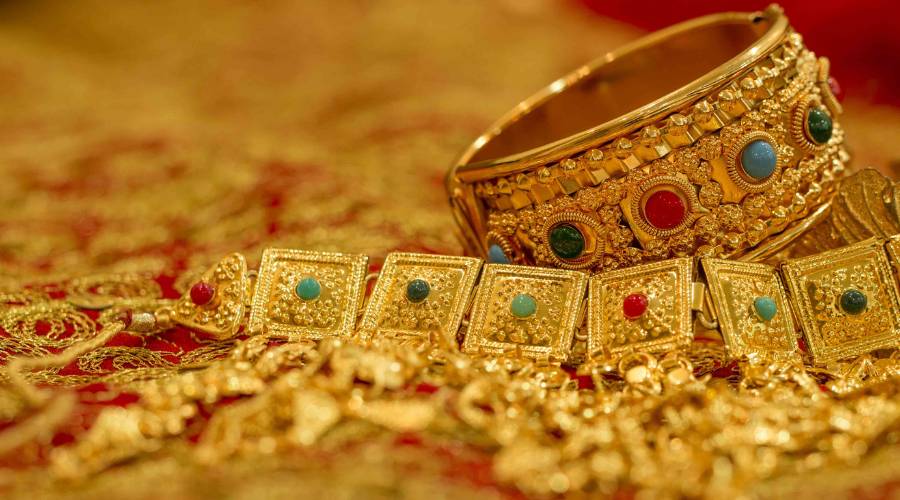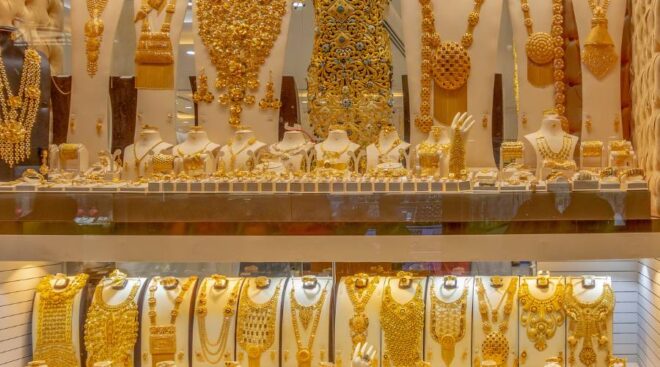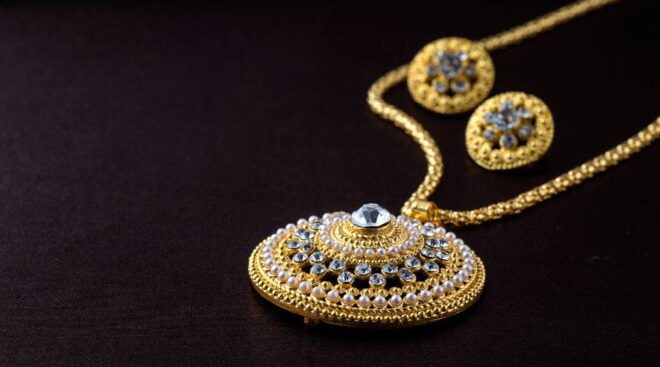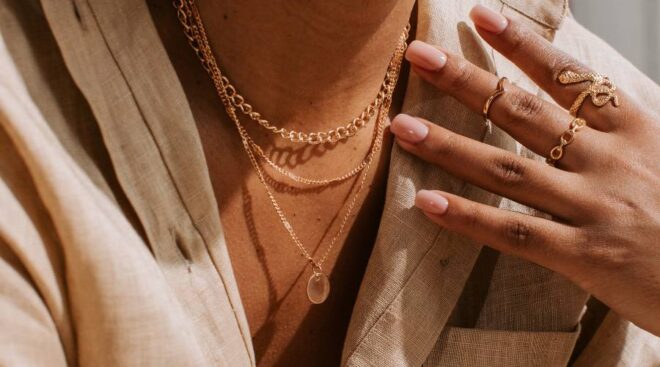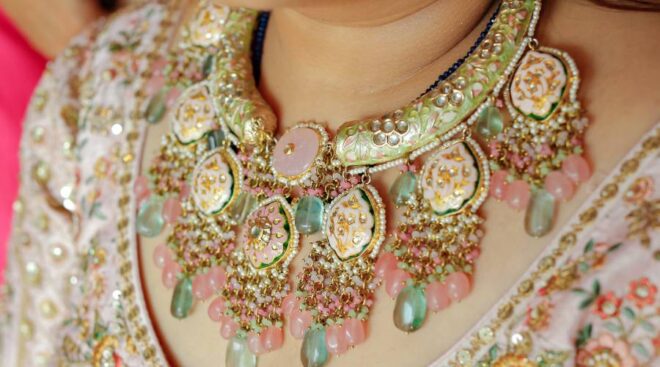Gold jewellery and silver jewellery have always been popular choices for fashion and personal adornment. Their timeless appeal continues to captivate individuals, making them suitable for various occasions, from everyday elegance to extravagant celebrations. Understanding the details of these precious metals is crucial before you make a purchase. Each metal has its advantages and disadvantages that can greatly influence your buying decision.
Exploring the pros and cons of both gold and silver jewellery can help you align your choice with personal preferences, budget constraints, and styling needs. This article serves as a comprehensive guide designed to provide you with the information needed to make a well-informed decision. Whether you’re investing in a bridal jewellery set or looking for elegant earrings for daily wear, knowing these key factors ensures your selection will bring joy and satisfaction for years to come.
1. Gold Jewellery
Gold jewellery holds a revered place in the world of adornment, celebrated for its timeless appeal and luxurious allure. This section explores the advantages that make gold a preferred choice for many.
Advantages of Gold Jewellery
1. Durability
A chief characteristic of gold is its durability. As a noble metal, gold is resistant to tarnish and corrosion, ensuring that your pieces remain pristine over time. This enduring nature makes gold jewellery a worthwhile investment, often becoming cherished family heirlooms passed down through generations.
2. High Resale Value
One of the defining features of gold jewellery is its high resale value. Gold’s scarcity and desirability in the market contribute to its superior resale potential compared to silver. Whether it’s a bridal necklace set or designer earrings, gold’s inherent worth retains substantial monetary value, providing an assurance of liquidity if ever needed.
3. Low Maintenance
Unlike other metals, gold requires less frequent maintenance to maintain its lustre. Its resistance to oxidation means you won’t need to polish it often, making it an ideal choice for those seeking elegance without regular upkeep. A simple wipe with a soft cloth can keep your gold pieces looking as radiant as the day they were crafted.
These advantages highlight why many turn to gold when seeking jewellery that combines beauty with practicality. Whether adorning yourself with modern charm or embracing timeless elegance, gold pieces effortlessly blend with any style or occasion—be it for weddings or everyday sophistication.
The qualities of gold do not just stop at aesthetics; they extend into practical benefits that underscore why this metal has stood the test of time in jewellery design. The allure of owning something both beautiful and durable makes gold an attractive option for those wanting their purchases to be both meaningful and valuable.
Exploring these advantages allows you to appreciate why investing in gold jewellery can be so rewarding. With each piece offering both aesthetic pleasure and financial security, choosing gold might just be the decision that best aligns with your style preferences and long-term investment goals.
Disadvantages of Gold Jewellery
While gold jewellery has many advantages, some drawbacks may affect your buying decision.
1. Cost
The main factor to consider is the cost. Gold is valuable because it is rare and highly desired, which makes solid gold items quite expensive. This can be a problem for people on a tight budget.
2. Quality and Price Variations
Gold is known as a noble metal because it doesn’t rust or corrode, making it durable. However, this durability comes with a price. To reduce the cost of pure 24K gold, it is often mixed with other metals, resulting in lower karat options like 14K or 18K. These variations affect both quality and price.
3. Malleability and Strength
Gold’s malleability allows for intricate designs, but it also means that higher-karat golds are softer and more susceptible to damage. On the other hand, lower karat golds are stronger but may not have the same shiny appearance.
4. Maintenance Challenges
There are different colour variations of gold such as yellow, white, and rose gold to suit various style preferences. However, these variations come with their maintenance challenges. For example, white gold may need to be re-plated over time to maintain its look, which adds to long-term costs.
2. Silver Jewellery
Silver jewellery shines with a distinctive bright shine, making it a popular choice for many looking to add elegance and sophistication to their accessory collection. This precious metal is celebrated for its versatility and ability to enhance various styles, from classic to contemporary.
Characteristics of Silver
1. Composition
Silver is often mixed with copper to produce sterling silver, enhancing its durability while retaining most of its shiny appeal. Sterling silver typically contains 92.5% silver and 7.5% other metals, usually copper.
2. Purity and Use
There’s a distinction between fine silver (99.9% pure) and sterling silver. Fine silver, although purer, is softer and less durable, making it less common in jewellery-making compared to thrust sterling silver.
3. Cost-effectiveness
Compared to gold, silver jewellery offers a more budget-friendly option without compromising on style or quality. This affordability allows you to build a diverse collection that includes various designs and pieces.
Advantages of Silver Jewellery
- Versatility: Silver’s neutral tone makes it ideal for creating vibrant layered or stacked looks, allowing you to experiment with versatile styling options that can elevate any outfit. Whether it’s layering necklaces or stacking bangles, silver pieces offer endless possibilities.
- Affordability: The lower price point of silver jewellery enables enthusiasts to purchase exquisite designs without straining their budgets, making it perfect for everyday wear or special occasions.
- Stylistic Range: The metal’s adaptability lends itself well to both minimalist designs and elaborate statement pieces, making it suitable for various tastes and preferences.
Disadvantages of Silver Jewellery
Despite these benefits, silver does have some drawbacks:
- Tarnishing Issues: A notable disadvantage is its tendency to tarnish over time when exposed to air and moisture. Regular cleaning and maintenance are necessary to keep your pieces looking their best and prevent significant discolouration.
- Durability Concerns: Although alloying enhances its strength, sterling silver can still be prone to scratches and dents if not handled carefully during wear or storage.
When considering your jewellery shopping guide, these characteristics of silver should inform your choices, especially if you’re seeking elegance without the hefty price tag associated with gold. This balance between affordability and aesthetic appeal makes silver an enduring favourite in the world of adornments.
Skin Tone Compatibility: Gold vs. Silver
Understanding skin tone compatibility in jewellery is essential when choosing between gold and silver pieces. Each metal complements skin tones differently, enhancing your natural beauty and elevating your style.
Gold Jewellery
Gold jewellery is often preferred by individuals with warm undertones. The rich, yellow hue of gold accentuates the golden or peachy notes in warm skin tones, creating a harmonious balance. Gold jewellery can add a touch of luxury and sophistication to any outfit, whether you’re opting for a classic bridal necklace set or modern statement earrings.
Silver Jewellery
Silver jewellery is best suited for those with cool undertones. The bright, reflective nature of silver contrasts beautifully with cooler skin tones, highlighting their pink or blue undertones. Silver’s versatility makes it perfect for layering, allowing wearers to play with different styles such as a silver choker or delicate earring and tikka set.
For individuals with neutral undertones, both metals can be flattering. Experimenting with mixed-metal looks can offer unique styling opportunities, blending the warmth of gold with the cool elegance of silver. This approach not only caters to personal preference but also aligns with current trends in jewellery fashion.
Selecting the right metal enhances your overall appearance while expressing your style.
Considerations for Sensitive Skin: Metal Allergies and Hypoallergenic Options
When choosing jewellery, it’s crucial to consider potential metal allergies, particularly if you have sensitive skin. Nickel, commonly found in certain silver alloys, is a known irritant that can cause allergic reactions. This makes it important to be mindful of the composition of silver pieces, especially those made from sterling silver, which may contain nickel.
Key Points to Consider:
- Nickel Presence: Many silver jewellery items are crafted from sterling silver, an alloy that sometimes includes nickel. For individuals prone to metal allergies, this can lead to skin irritation or discomfort.
- Gold as a Hypoallergenic Option: Gold jewellery offers a safer alternative for those with sensitive skin. Pure gold is hypoallergenic and poses a lower risk of causing allergic reactions. Opting for higher karat gold (such as 18K or 24K) further reduces the likelihood of encountering allergenic metals within the alloy.
Choosing the right metal can significantly impact comfort and wearability, especially for bridal sets or statement pieces worn over extended periods. Understanding these nuances helps in making well-informed decisions that balance both beauty and health considerations.
Mixing Metals: Embracing the Trendy Mixed-Metal Looks
The mixed-metal style is gaining traction as a bold fashion statement. Gold and silver jewellery, when combined, create a unique aesthetic that captures attention and reflects personal flair. This trend allows you to break conventional jewellery norms by blending the rich warmth of gold with the cool shine of silver.
1. Versatile Styling
Mixed-metal designs are ideal for those who enjoy versatility in their accessories. Pairing gold bangles with silver rings or stacking gold and silver necklaces can elevate any outfit, offering both elegance and modern sophistication.
2. Fashion Forward
Celebrities and influencers frequently showcase mixed-metal looks, setting trends that resonate with fashion enthusiasts worldwide. This approach encourages individuality, allowing wearers to experiment with different textures and finishes.
3. Timeless Appeal
Despite its contemporary edge, this style retains an element of timelessness. Whether for everyday wear or special occasions like weddings, mixed metals can enhance modern charm while preserving classic elegance.
Explore the new collection at Aladdin’s Chest, where you can find impeccably crafted pieces designed to embrace this trend. From designer bangles to layered necklaces, these exquisite pieces are perfect for those seeking to stand out with grace and sophistication.
Conclusion
Choosing between gold and silver jewellery is a personal journey that reflects your unique style and financial considerations. When making this choice, it’s essential to consider the durability and resale value of gold jewellery compared to the versatility and affordability of silver pieces. Each metal has its advantages and challenges, suited to different preferences and needs.
If you’re looking for exquisite craftsmanship in either metal, visit Aladdin’s Chest. We offer jewellery that beautifully combines timeless elegance with modern sophistication. Explore our collection to find pieces that cater to your tastes and enhance your style.
What are the main advantages of gold jewellery?
Gold jewellery is known for its durability, high resale value, and low maintenance. Its ability to withstand the test of time makes it a worthwhile investment, while its scarcity and desirability in the market contribute to a higher resale value compared to silver.
How does silver jewellery compare to gold in terms of cost?
Silver jewellery is generally more cost-effective than gold, making it an attractive choice for budget-conscious shoppers. While gold can be a significant investment due to its higher price per gram, silver offers a more affordable option without compromising on style.
What should I consider regarding skin tone compatibility when choosing between gold and silver?
Different metals complement various skin tones. Gold tends to suit warm undertones better, while silver is often recommended for cool undertones. Understanding your skin tone can help you select jewellery that enhances your overall appearance.
Are there any disadvantages to owning silver jewellery?
Yes, one of the main disadvantages of silver jewellery is its tendency to tarnish over time. This requires regular cleaning and maintenance to keep it looking its best. Additionally, some silver alloys may contain nickel, which can cause allergic reactions in sensitive individuals.
Can individuals with sensitive skin wear gold jewellery safely?
Yes, gold jewellery is generally safer for individuals with sensitive skin since it has a lower risk of causing allergies. Opting for higher-purity gold (such as 24K) can further minimize allergy risks associated with certain alloys found in lower-karat options.
What is the trend regarding mixing gold and silver jewellery?
Current trends embrace mixing metals, allowing individuals to create unique aesthetics by combining gold and silver pieces. This trendy mixed-metal look not only stands out but also provides versatile styling options for various outfits.


